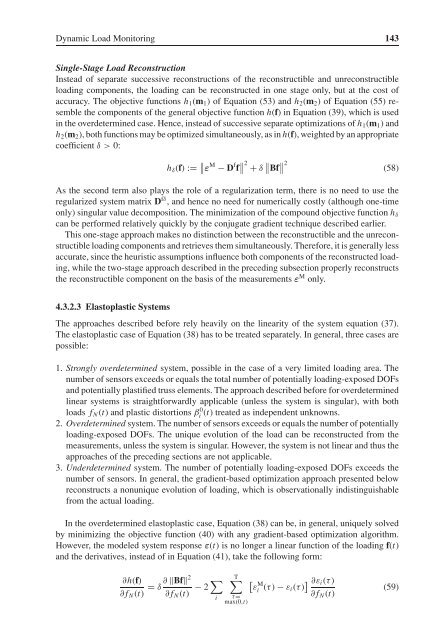smart technologies for safety engineering
smart technologies for safety engineering
smart technologies for safety engineering
You also want an ePaper? Increase the reach of your titles
YUMPU automatically turns print PDFs into web optimized ePapers that Google loves.
Dynamic Load Monitoring 143<br />
Single-Stage Load Reconstruction<br />
Instead of separate successive reconstructions of the reconstructible and unreconstructible<br />
loading components, the loading can be reconstructed in one stage only, but at the cost of<br />
accuracy. The objective functions h1(m1) of Equation (53) and h2(m2) of Equation (55) resemble<br />
the components of the general objective function h(f) in Equation (39), which is used<br />
in the overdetermined case. Hence, instead of successive separate optimizations of h1(m1) and<br />
h2(m2), both functions may be optimized simultaneously, as in h(f), weighted by an appropriate<br />
coefficient δ>0:<br />
hδ(f) := ε M − D f f 2 + δ Bf 2<br />
As the second term also plays the role of a regularization term, there is no need to use the<br />
regularized system matrix D fδ , and hence no need <strong>for</strong> numerically costly (although one-time<br />
only) singular value decomposition. The minimization of the compound objective function hδ<br />
can be per<strong>for</strong>med relatively quickly by the conjugate gradient technique described earlier.<br />
This one-stage approach makes no distinction between the reconstructible and the unreconstructible<br />
loading components and retrieves them simultaneously. There<strong>for</strong>e, it is generally less<br />
accurate, since the heuristic assumptions influence both components of the reconstructed loading,<br />
while the two-stage approach described in the preceding subsection properly reconstructs<br />
the reconstructible component on the basis of the measurements ε M only.<br />
4.3.2.3 Elastoplastic Systems<br />
The approaches described be<strong>for</strong>e rely heavily on the linearity of the system equation (37).<br />
The elastoplastic case of Equation (38) has to be treated separately. In general, three cases are<br />
possible:<br />
1. Strongly overdetermined system, possible in the case of a very limited loading area. The<br />
number of sensors exceeds or equals the total number of potentially loading-exposed DOFs<br />
and potentially plastified truss elements. The approach described be<strong>for</strong>e <strong>for</strong> overdetermined<br />
linear systems is straight<strong>for</strong>wardly applicable (unless the system is singular), with both<br />
loads fN (t) and plastic distortions β 0 i<br />
(t) treated as independent unknowns.<br />
2. Overdetermined system. The number of sensors exceeds or equals the number of potentially<br />
loading-exposed DOFs. The unique evolution of the load can be reconstructed from the<br />
measurements, unless the system is singular. However, the system is not linear and thus the<br />
approaches of the preceding sections are not applicable.<br />
3. Underdetermined system. The number of potentially loading-exposed DOFs exceeds the<br />
number of sensors. In general, the gradient-based optimization approach presented below<br />
reconstructs a nonunique evolution of loading, which is observationally indistinguishable<br />
from the actual loading.<br />
In the overdetermined elastoplastic case, Equation (38) can be, in general, uniquely solved<br />
by minimizing the objective function (40) with any gradient-based optimization algorithm.<br />
However, the modeled system response ε(t) is no longer a linear function of the loading f(t)<br />
and the derivatives, instead of in Equation (41), take the following <strong>for</strong>m:<br />
∂h(f) ∂ Bf2 <br />
= δ − 2<br />
∂ fN (t) ∂ fN (t)<br />
i<br />
T<br />
τ=<br />
max(0,t)<br />
ε M i (τ) − εi(τ) ∂εi(τ)<br />
∂ fN (t)<br />
(58)<br />
(59)
















